




suggested donation goes directly to your vendor STREETSENSEMEDIA.ORG @ STREETSENSEDC Real Stories Real People Real Change $2 E d ition VOL. 19 ISSUE 48 OCTOBER 19 - 25, 2022 A conversation with Shepherd’s Table What to expect from DCHA’s housing voucher reform Learn how Stepping Stones Shelter helps families find homes 4 6 8
VENDOR CODE OF CONDUCT
As self-employed contractors, our vendors follow a code of conduct.

1. I will support Street Sense Media’s mission statement and in so doing will work to support the Street Sense Media community and uphold its values of honesty, respect, support, and opportunity.
2. I will treat all others, including customers, staff, volunteers, and fellow vendors, respectfully at all times. I will refrain from threatening others, pressuring customers into making donations, or engaging in behavior that condones racism, sexism, classism, or other prejudices.
3. I understand that I am not an employee of Street Sense Media but an independent contractor.
4. While distributing the Street Sense newspaper, I will not ask for more than $2 per issue or solicit donations by any other means.
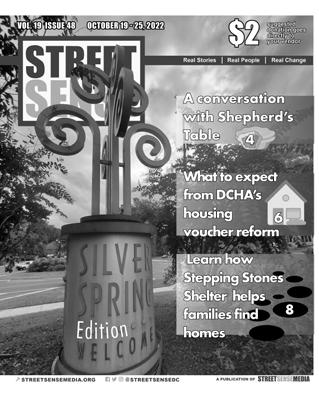
5. I will only purchase the newspaper from Street Sense Media staff and volunteers and will not distribute newspapers to other vendors.
6. “I will not distribute copies of “Street Sense” on metro trains and buses or on private property.”
7. I will abide by the Street Sense Media Vendor Territory Policy at all times and will resolve any related disputes with other vendors in a professional manner.
8. I will not sell additional goods or products while distributing “Street Sense.”

9. I will not distribute “Street Sense” under the influence of drugs or alcohol.
10. I understand that my badge and vest are property of Street Sense Media and
deface them.
present
and will
“Street Sense.”
PHOTO BY ATHIYAH AZEEM
G Street NW, Washington, DC 20005 (202) 347 - 2006 streetsensemedia.org info@streetsensemedia.org
VENDORS
Abel Putu, Abraham Aly, Aida Peery, Amina Washington, Andre Brinson, Andrew Anderson, Angie Whitehurst, Anthony Carney, Anthony Pratt, Archie Thomas, August Mallory, Betty Everett, Beverly Sutton, Bob Davis, Brianna Butler, Brandon Archer, Candice Wilkes, Carlos Carolina, Carlton Johnson, Carol Motley, Charles Armstrong, Charles Woods, Chon Gotti, Chris Cole, Chris Sellman, Conrad Cheek, Corey Sanders, Cortney Signor, Daniel Ball, David Snyder, Debora Brantley, Degnon (Gigi) Dovonou, Don Gardner, Donté Turner, Doris Robinson, Earl Parker, Eric Glover, Eric Thompson-Bey, Erica Downing, Evelyn Nnam, Floyd Carter, Franklin Sterling, Frederic John, Fredrick Jewell, Gerald Anderson, Gracias Garcias, Henry Johnson, Ivory Wilson, Jacqueline “Jackie” Turner, Jacquelyn Portee, James Davis, Jeanette Richardson, Jeff Taylor, Jeffery McNeil, Jeffrey Carter, Jemel Fleming, Jenkins Daltton, Jennifer McLaughlin, Jermale McKnight, Jet Flegette, Jewel Lewis, John Littlejohn, Joshua Faison, Juliene Kengnie, Justin Blakey, Katrina Arninge, Kenneth Middleton, Khadijah Chapman, Kym Parker, L. Morrow, Laticia Brock, Laura Smith, Lawrence Autry, Levester Green, Malcolm Scott Jr, Marcus McCall, Mark Jones, Mango Redbook, Maurice Spears, Melody Byrd, Michael Warner, Michelle Mozee, Michele Rochon, Mildred M. Hall, Morgan Jones, Patricia Donaldson, Patty Smith, Phillip Black, Queenie Featherstone, Reggie Jones, Reginald Black, Reginald C. Denny, Ricardo Meriedy, Rita Sauls, Robert Warren, Rochelle Walker, Ron Dudley, Sasha Williams, Shawon McCrary, Sheila White, Shuhratjon Ahmadjonov, Susan Westmoreland, Susan Wilshusen, Sybil Taylor, Warren Stevens, Wendell Williams
BOARD OF DIRECTORS
Mary Coller Albert, Blake Androff, Jonquilyn Hill, Greg Jaffe, Stanley Keeve, Clare Krupin, Ashley McMaster, Matt Perra, Michael Phillips, Daniel Webber, Shari Wilson, Corrine Yu
CHIEF EXECUTIVE OFFICER
Brian Carome
DIRECTOR OF DEVELOPMENT AND COMMUNICATIONS
Doris Warrell
DIRECTOR OF PROGRAMS
Darick Brown
DIRECTOR OF VENDOR EMPLOYMENT
Thomas Ratliff
VENDOR PROGRAM ASSOCIATES
Aida Peery, Clifford Samuels
VENDOR PROGRAM VOLUNTEERS
Roberta Haber, Ann Herzog, Madeleine McCollough, Dylan Onderdonksnow
MANAGER OF ARTISTIC
Lares
EDITOR-IN-CHIEF
Schick
DEPUTY
Azeem
STAFF
EDITORIAL
MICHAEL
ARTISTS-IN-RESIDENCE
Ariane Mohseni (Film), Bonnie Naradzay (Poetry), David Serota (Illustration), Lalita Clozel (Film), Willie Schatz (Writing)
ARTS
Model
(VOLUNTEER)
OPINION EDITORS (VOLUNTEER)
Rebecca Koenig, Emily Kopp, Lydia DePillis, Bill Meincke, Candace Montague
EDITORIAL
Josh Axelrod, Ryan Bacic, Katie Bemb, Lilah Burke, Chelsea Ciruzzo, Lenika Cruz, Alison Henry, Kathryn Owens, Nick Shedd, Andrew Siddons, Jenny-lin Smith, Rebecca Stekol
2 // STREET SENSE MEDIA // OCTOBER 19 - 25, 2022
will not
I will
my badge when purchasing “Street Sense”
always display my badge when distributing
INTERESTED IN BEING A VENDOR? New vendor training: every Tuesday and Thursday // 2 p.m. // 1317 G St., NW NO CASH? NO PROBLEM. How It Works Each vendor functions as an independent contractor for Street Sense Media, managing their own business to earn an income and increase stability in their life. Street Sense Media publishes the newspaper BUSINESS MODEL YOUR SUGGESTED $2.00 DONATION goes directly to your vendor, empowering them to overcome homelessness and poverty per newspaper copy $.50 Vendors pay Pay vendors with the Street Sense Media app! S earch “S treet S en S e ” in your app S tore . AVAILABLE The Street Sense Media Story, #MoreThanANewspaper Originally founded as a street newspaper in 2003, Street Sense Media has evolved into a multimedia center using a range of creative platforms to spotlight solutions to homelessness and empower people in need. The men and women who work with us do much more than sell this paper: They use film, photography, theatre, illustration, and more to share their stories with our community. Our media channels elevate voices, our newspaper vendor and digital marketing programs provide economic independence. And our in-house case-management services move people forward along the path toward permanent supportive housing. At Street Sense Media, we define ourselves through our work, talents, and character, not through our housing situation. The Cover A welcome sign for those entering Silver Spring from D.C. on 16th Street.
© STREET SENSE MEDIA 2003 - 2022 1317
WORKSHOPS Maria
Will
EDITOR Kaela Roeder PRODUCTION EDITOR Athiyah
REPORTER Annemarie Cuccia
INTERN Neil Franklin
STOOPS DIVERSITY FELLOW Sophia Thomas
EDITOR
Austine
VOLUNTEERS
Dropping ‘DC’ from our Homeless Crisis Reporting Project
AT A GLANCE VENDOR PROGRAM ANNOUNCEMENTS
• The next vendor meeting will be Friday, Oct. 28, at 2 p.m. Food, drinks, and discussion!
• New workshops and workshop times!
• Watercolor workshop is every Tuesday at 11:45 a.m
• Women’s workshop is every Tuesday at 2 p.m.
• Theater workshop is every Wednesday at 11:45 a.m. on the 3rd floor.
• Photography workshop is every Thursday at 11:45 a.m.
BIRTHDAYS
Last week, our newsroom led a group of regional news outlets on a project to report on homeless issues for one week. Formerly known as the “DC Homeless Crisis Reporting Project,” this effort initially started as a way to convince other outlets to pay attention to homelessness for one day a year.

After six years and over a hundred stories, we decided it was time to drop “DC” from our project name. Given the previous success of the project, we felt it was important to begin expanding our coverage beyond the District. As a result, our previous reporting page: dchomelesscrisis.press has now been updated to a new domain homelesscrisis. press. It features all of our past stories and our latest reporting. In the past week, our news collaboration yielded deeply reported stories about homelessness in D.C., Maryland and Virginia.
In addition to past articles, this webpage also carries our newly published journalist’s guide for reporting on homelessness. This guide, while imperfect, is a living document we will be continuing to work on throughout the year. In the spring, we aim to debut a few additions to include a glossary of terms and definitions and interview guidance. Eventually, we hope to make our project site a resource hub for journalists and members of the public who would like to learn more about homelessness.
In the future, our newsroom will seek to establish smaller scale reporting collaborations with other regional outlets seeking to report on poverty and homelessness. This means we will be moving away from conducting massive scale annual reporting events and instead seek to oversee more in-depth, smaller-scale projects that take place throughout the year.
Next month, we will be hosting a hybrid online and in-person event bringing together journalists and members of the community to talk about media coverage of homelessness. And early next year, we will be training a small cohort of five reporters from various regional outlets on solutions journalism and lead them in producing stories about the housing crisis.
All of the news stories that appear in this week’s edition are part of our newly established Homeless Crisis Reporting Project. Since the intent behind this project was to expand our coverage, we felt it important to showcase two articles we produced that spotlight the work of homeless services nonprofits based in Maryland. Over the coming months, readers should expect to see more regional stories in addition to our award-winning local D.C. coverage.
However, not everything in this issue is strictly Maryland-focused. On pages six to seven, we have an in-depth look at the challenges the DC housing authority faces administering vouchers. Page 10 features an opinion article from long-time homeless rights advocate Jewel Stroman and details her personal experience with navigating housing vouchers.
Will Schick, Editor-in-Chief
Martin Walker
Artist/Vendor
Oct. 19
Vincent Watts
Artist/Vendor
Oct. 19
Rita Sauls
Artist/Vendor
24
Daniel Ball
Artist/Vendor
25
STREETSENSEMEDIA.ORG // 3 NEWS IN BRIEF
Oct.
Oct.
A seat for everyone
Street Sense Media chats with Silver Spring-based homeless services provider Shepherd’s Table
SOPHIA THOMAS Michael Stoops Diversity Fellow
Nearly 40 years ago, Shepherd’s Table was just a tiny soup kitchen in the back of a church in Silver Spring, Md. Today, it’s a fully functioning facility, serving over 500 nutritious meals a day and offering essential goods and services to every individual that passes through its doors. Manny Hidalgo is the executive director at Shepherd’s Table. Street Sense Media spoke with him about the organization’s services, the people it serves and how it was affected by the pandemic.
Tell me what led you to work in homeless services.
When I was an undergraduate student at Georgetown University, we had a priest named Father Tom King who used to hold a vigil every February to bring light to the fact that we had so many homeless people. This was in the late 80s, so we had upwards of 50,000 homeless people in D.C. We would invite homeless people in the Georgetown area to come on campus and have a candlelight vigil, and then we would sleep outside in solidarity with them.
It really alerted me to just how dangerous it was to be sleeping outside on a cold winter night. Like a lot of people, I came to Washington thinking I would go into law, maybe work in Congress, but when I saw the degree to which so many people were being left behind, it changed my whole life trajectory. I think working with people experiencing homelessness is where you really get to have the most impact, and I’ve always felt like I wanted to be where I could have the most impact.
Without a doubt, it’s the staff. It’s a wonderful, very committed staff, most of whom have been here for at least seven or eight years. It’s also a small staff. Right now we’re up to about 22 full-timers and yet we (serve)130,000 meals a year in addition to a whole host of social services. We have about 2,000 volunteers. Between the staff and the volunteers, just getting to know them and working with them in solidarity. The board is about 24 people, and they’re all incredibly passionate and committed. A lot of them live in the neighborhood and a lot of them have always felt this is part of why they want to be in Silver Spring, because it's taken that approach towards people experiencing homelessness of “Yes, in my backyard. We want you here and we want to serve you. We want to see you get to a better place and be on that journey with you.” It’s such a unique place. I love the people I work with.
Bring me into the atmosphere of a meal at Shepherd’s Table.
It starts with the volunteers coming in a couple of hours before. They wash up, they put on their aprons, talk to the chef, and find out what’s needed. Often there’s some chopping and meal prep to do. You start to feel the heat from the kitchen,
you start to smell the aromas. Things get louder, a little more active and energetic. We do a quick meeting where the chef goes over who’s going to be in the service line, who’s going to be wiping down tables, who’s doing the line count, who’s going to be doing the dishes. Dishes aren’t something you do just at the end of the meal, especially when you’re feeding 150 people! It’s almost like watching an orchestra, with everyone taking their places before the curtains open.
In the meantime, we’ve got the security outside lining everybody up. Everybody’s getting excited, they’re asking what’s for dinner. Somebody writes it up on a chalkboard. Folks who use a walker or are wheelchair-bound come first, they get their meals and have a volunteer assigned to help them get to a table. People are very courteous to each other and the people serving the meals. They get their food, they get through the line, and they find a place to sit. Usually, they’re out within 15 to 20 minutes. As they leave, more folks are filing in. It’s a very efficient process.
A lot of people use mealtime to catch up. You see a lot of folks talking, there’s always a lot of chatting and banter and conversation. A lot of the volunteers have been coming for a long time, so there are a lot of volunteers catching up with meal guests. It’s very warm. It gives off the vibe of the Thanksgiving experience because people are really familiar with each other.
How many meals are you serving per day?
It’s usually anywhere from 300 to 500 at Progress Place, our headquarters, and another 150 at Beyond the Table (a program that distributes to-go meals at sites in Montgomery and Prince George’s County). So it’s really anywhere from 450 to 650 meals if you combine the two.
Your website mentions that of the 80,000 people in Montgomery County experiencing food insecurity, most of them are immigrant women and children. Tell me about the demographics of the people you serve.
Through Beyond the Table, we serve meals at two locations: Parkland Middle School in Aspen Hill, and Riverdale by College Park. There, it’s overwhelmingly immigrant women and children. When it comes to Progress Place, it’s more older African American men which is typically what you see in D.C.
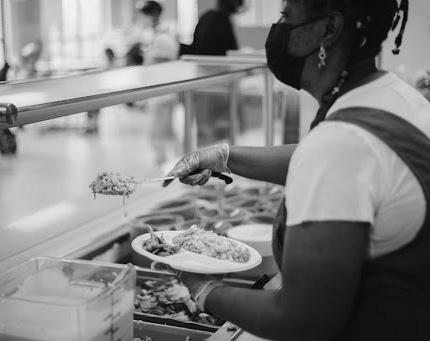
4 // STREET SENSE MEDIA // OCTOBER 19 - 25, 2022 NEWS
What’s your favorite part about working at Shepherd’s Table?
A Shepherd’s Table volunteer serves a meal. Photo by Shepherd’s Table
How would you describe the impact of having a good meal for a person who is food insecure or experiencing homelessness?

It’s necessary before you can do anything. It’s hard to make any good decision on an empty stomach. A decision to take your medication, a decision to sign up for that GED class, a decision to get out of a bad relationship, to sign up to get an apartment, to go look for a job. Having a healthy, nutritious meal is a building block for all other important decisions one makes in a day. If there’s anything you get right today, let it be what you put in your body. Hopefully, every other decision will be a good one emanating from that first, most central, important decision one makes.
Mealtime is also a moment of engagement. For us, we see mealtime as an opportunity to exchange information, to say “Hey, I haven’t seen you since last week, how’s it going with that opportunity I told you about?” I can’t tell you how many ongoing conversations I’ve had over mealtime. It’s that time to really connect and follow up and see how we can do more.
How did Shepherd's Table come to determine the social service programs it offers? Which services are utilized the most?
Mail is super popular because people need to have an address. We have grants that allow us to help cover the cost of prescription meds. We also do a lot of case management and referrals, whether it’s for housing, mental health or other services. We have an art fair people come to on the weekends. We also do haircuts, bus tokens, and we’ll help people sign up for benefits like food stamps. Lately with what’s been going on with Governor Abbott and DeSantis sending migrants up here, we’ve been getting some of the Venezuelan and Nicaraguan migrants and helping them sign up for immigration and legal
assistance to make sure they don’t get deported. We have an ongoing expungement clinic helping people expunge charges that the homeless end up with. Toiletries are big, underwear, socks, feminine hygiene products. We have a full clothing closet that’s super popular. It’s whatever’s needed. We’ll engage with them in any way that can be supportive and help them get ahead.
The demand for your services has increased by 59% since the pandemic began. How has Shepherd's Table managed this influx?

We were very fortunate that for 2020 and 2021 our donations went up. A lot of people forwarded their stimulus checks to us. We were able to weather the storm with those additional and individual donations. The county pitched in more, foundations stepped up, places of worship stepped up. We’ve fortunately been able to continue to keep pace with the growth of demand.
Shepherd's Table petitioned for a 59% increase in funding to match the rise in demand. Has the Montgomery County Council agreed to meet this increase for FY23?
They didn’t. We haven’t seen an increase in government (funding). This year we’ll probably see a deficit. After two years of record surpluses, in the aggregate, we’ll be fine. But unfortunately, we’ve not been able to get the county to step up.
Describe Shepherd's Table's relationship with the larger community through the pandemic.
The total number of volunteers has gone down by around 400 because of Covid. At the height of COVID, we told everyone over the age of 65 not to come, which is a big portion of our volunteers. But we’ve been back to normal, asking everyone to come back now for at least the whole year so we’re getting back up there. In 2023, our numbers should be where they were before the pandemic. But we’re still feeling a need for more volunteers. We’re not out of the woods yet.
STREETSENSEMEDIA.ORG // 5
Shepherd’s Table volunteers prepare a meal. Photo by Shepherd’s Table
A meal is served to a guest at Shepherd’s Table. Photo by Shepherd’s Table
Inside the confusing world of housing choice vouchers
ANNEMARIE CUCCIA Staff Reporter
People using housing vouchers in D.C. spent this past summer in limbo. In the spring, the D.C. Housing Authority (DCHA) deliberated changing the maximum value of all 20,000 vouchers the agency administers. If implemented, the change could have had major consequences, advocates and landlords warned, by inadvertently forcing thousands of people to move from their homes. Not until last month did the agency make clear that no changes are imminent.
The city’s embattled housing authority recently came under fire in an unsparing assessment by the U.S. Department of Housing and Urban Development (HUD). While media attention focused largely on the low occupancy rates and subpar condition of DCHA-run public housing, the agency’s oversight of its voucher program is also lacking, according to the report. DCHA is out of compliance with several HUD voucher regulations, and has been widely criticized for failing to hold landlords accountable for high rental costs. This summer, DCHA Executive Director Brenda Donald publicly stated that officials don’t know exactly how some of the Housing Authority’s current voucher rents were calculated (they were implemented long before she joined the agency last year). What’s clear, however, is that the existing rates DCHA uses are premised on years-old market conditions.
The agency is set to spend at least the next year determining how to revise the value of the 20,000 vouchers it administers. In doing so, the agency will have to grapple with concerns that landlords are exploiting the program, and that people with vouchers are unable to find suitable homes to rent. The end result could have lasting consequences not just for D.C.'s voucher holders, but for all those in the city who rely on affordable housing.
Housing vouchers 101
Reginald Black lives in an apartment in Northwest D.C. Like many residents across the city, he relies on a housing voucher. He pays 30% of his income toward his rent in an apartment of his choice while the District covers the rest. This subsidy is a lifeline for thousands of D.C. residents exiting homelessness or making too little to afford to live in the city. But many people with vouchers still experience housing instability, enduring discrimination from landlords, poor housing conditions and mounds of paperwork to receive their monthly subsidy. In May, DCHA — the agency that administers the vouchers — almost added another complication.
That month, Black came home to find a letter from his landlord stuck in his door. It warned Black that DCHA was considering paying less for his voucher. But his overall rent wasn’t going down. If he received a smaller subsidy, Black knew he would no longer be able to afford to stay in the apartment.
Landlords and tenants across the city watched similarly alarming alerts fill their inboxes. The missives outlined DCHA’s plans to decrease the maximum value of all its housing vouchers. Charts made by landlords and homeless service providers proliferated across the community, suggesting that up to 30% of voucher holders would be evicted if the Housing Authority followed through.
In September, DCHA quashed its proposal after months of
outcry. Officials have instead embarked on what’s shaking out to be a years-long process to reevaluate how much the agency will pay landlords to house people with vouchers. That amount — called a “voucher rent” — is supposed to be based on the literal cost of housing in D.C., but it also determines the city’s answer to a hotly debated question: Where should people who use vouchers be able to live?
How does DCHA determine the maximum value of a voucher?
The agency uses a complicated process for establishing the value of a housing voucher — so complicated, in fact, that DCHA Director Donald and her staff spent hours explaining it to the agency’s Board of Commissioners during this summer’s meetings. Officials say the complexity is unavoidable due to federal regulations and the nature of DC’s rental market.
The value of a housing voucher — i.e., the “voucher rent” — isn’t just a technical decision. It’s a key piece of the city’s housing policy. Set it too low, and people who use vouchers won’t be able to afford to live in middle- and upper-class neighborhoods, reinforcing D.C.’s intense racial and economic segregation. Set it too high, and landlords can take advantage of the high voucher rents, which can mean displacing other tenants to make more off renting to voucher holders.
There are three ways DCHA decides the value of a housing voucher.
First, the Housing Authority establishes the maximum value it will pay for any voucher in the city. In other words, no matter how much Black earns, his share of the rent (30% of his income) combined with DCHA’s share can’t exceed this cap.
Per federal requirements, the agency bases its calculations on a HUD assessment that establishes what it calls “fair market rent” for the region. Since the region includes lowercost areas like Northern Virginia and suburban Maryland, fair market rent understates the actual cost of housing in D.C.
So, DCHA multiplies fair market rent to get the maximum value of a voucher. Right now, it’s at 187% of fair market rent, almost twice the region’s. In practice, this means the agency can pay landlords up to $2,930 for a one-bedroom unit anywhere in the city. The maximum value fluctuates based on the type of unit, reaching $5,073 for a fourbedroom.
In May, DCHA proposed to decrease the maximum value from the current 187% to 110% of small area fair market rent (a second number released by HUD that measures the price of housing based on ZIP codes). The agency worried it was paying landlords too much to rent to voucher holders, and saw lowering the maximum value as the most feasible way to stop that overpayment. DCHA nixed the proposal in response to objections from landlords as well as advocates for low-income Washingtonians, who argued that a lower maximum value would make it impossible for people with vouchers to find housing in neighborhoods with high rents. For Fiscal Year 2023, the maximum value will stay at 187% of fair market rent.
Looking beyond the maximum value
Black and DCHA don’t pay the maximum value of almost $3,000 for his apartment, however. Instead, he and most voucher holders are charged based on a second calculation, called the “neighborhood approved rent.”
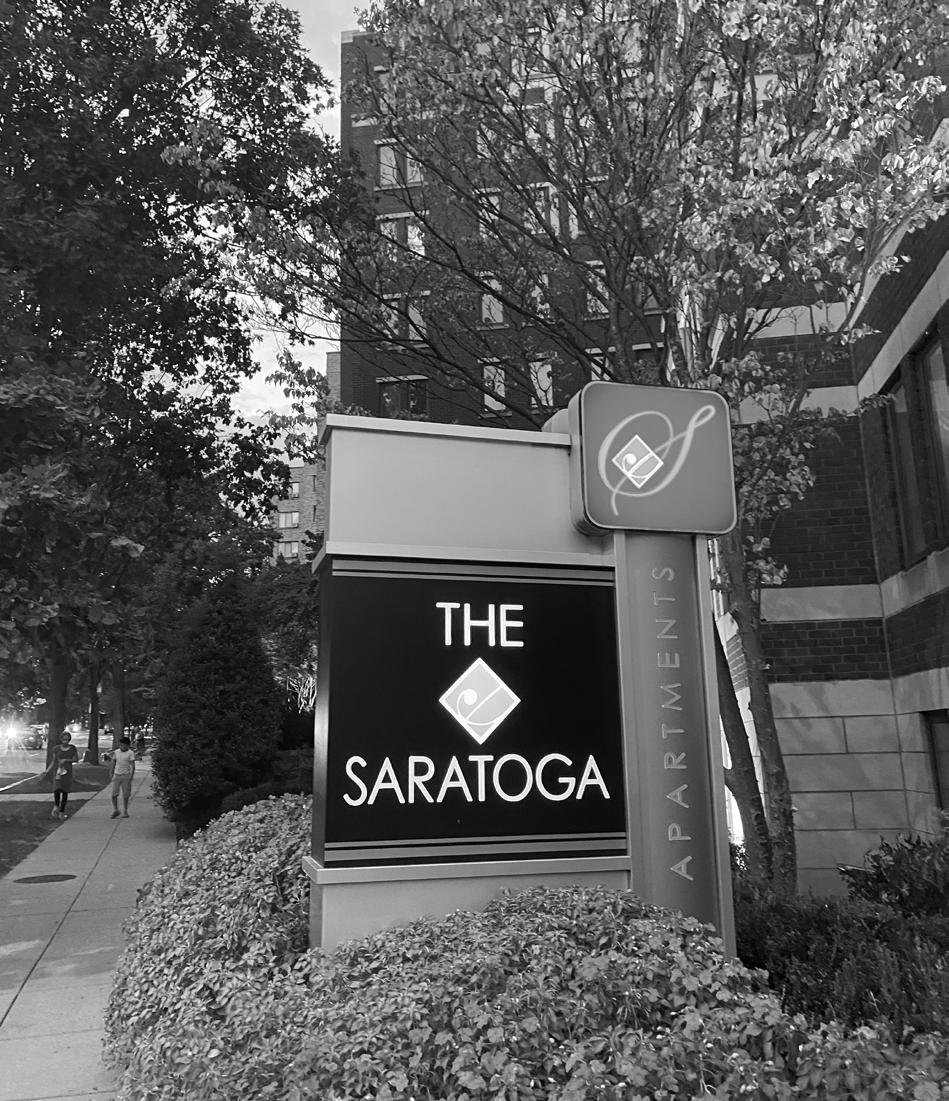
Once DCHA sets a maximum value for the whole city, the agency turns to voucher rent caps for each of D.C.'s 59 neighborhoods. These neighborhood rents act like the maximum value but on a localized level, setting varying caps to reflect housing costs across the city. In wealthier areas, the neighborhood rent ($2,648 for a one-bedroom where Black lives) approaches the maximum value. In lower-priced neighborhoods, DCHA sets a lower approved rent, such as $1,400 for a one-bedroom.
DCHA plans to overhaul the current neighborhood rents by 2024. A very early draft, prepared by an outside consultant, suggests increasing rents for many three-, fourand five-bedroom units, which can be especially hard to find in D.C. Landlords in neighborhoods that are paid the least — such as Anacostia, Barry Farm, Petworth and Shepherd Park — would see across-the-board increases. Meanwhile, areas where DCHA is currently paying the most — for instance, Capitol Hill, Cleveland Park and Mount Pleasant — would see significant decreases.
DCHA hasn’t updated the neighborhood rents since 2016, and an outside review conducted this summer suggested the currently used figures are outdated. The agency is overpaying for studios and one-bedrooms in 33 neighborhoods and underpaying for all units in 12 other neighborhoods, according to the study. (DCHA has questioned the study’s accuracy, and is following up to confirm data.)
6 // STREET SENSE MEDIA // OCTOBER 19 - 25, 2022 NEWS
Ward 3 Council candidate David Krucoff held a community meeting on housing vouchers at the Saratoga on Sept. 22. Photo by Annemarie Cuccia
When Black was searching for an apartment, he could look anywhere that charged up to the neighborhood rent. But once he found one, the Housing Authority had to figure out a third number: the fair rent for that specific apartment, which is how much Black and DCHA would actually pay the landlord each month.
The Housing Authority calls determining the actual rent a voucher holder and the authority pay to a landlord the “rent reasonableness process.” Under this policy, landlords cannot charge voucher holders more than they charge people without vouchers for comparable units in the same building or neighborhood. DCHA’s rent reasonableness review is a built-in control for overpayment by unit. That’s important because neighborhood rents technically allow DCHA to pay the same rent for voucher holders living in a new, luxury building as it does for those in an older building in the same neighborhood — even if the actual value of those units varies widely.
On paper, DCHA can evaluate the rent landlords propose to make sure it accounts for the building age, amenities and condition. But in practice, “it's unclear what DCHA's actual ‘process’ is to verify that unit rents are reasonable,” according to the HUD report. That echoes long-standing criticism from housing advocates.
DCHA did not provide HUD with any rent reasonableness records, but HUD found that DCHA is not following federal rent reasonableness guidelines. DCHA may accept all rents below the neighborhood maximum, the report said, which is against HUD regulations and allows landlords to exploit voucher rents. Prior to the HUD report’s release, a DCHA spokesperson indicated that the agency did not have any immediate plans to change its rent reasonableness process. HUD gave the agency 60 days to come up with a plan to address issues raised in its assessment.
Finding a suitable place to live
Queenie Featherstone, a Street Sense Media vendor, knows how hard it can be to find an apartment with a voucher. Some of the units she toured were infested with roaches and rats. And the rents seemed so high. Even if her voucher would cover $1,500 a month for a one-bedroom, Featherstone didn’t want to reward inflated prices.
“I refused to use the government’s money senselessly,” she insisted.
But Featherstone also needed certain things from her apartment, which she’s now found. “I wanted to pick a neighborhood that looked clean, safe, on a Metro or bus line, near grocery stores, that would work for me,” she said.
The tension Featherstone felt reverberates across the voucher rent-setting process: How can voucher holders live where they want without paying too much?
DCHA’s official policy is that people with housing vouchers should be able to live in any neighborhood across the city. But just like for Washingtonians who rent without assistance, housing costs in D.C. can be prohibitive.
“You cannot find any decent place to live with the current market rate,” Denise Blackson, a DCHA board member, said at a Sept. 14 meeting.
It used to be even harder. Ten years ago, a much lower maximum value in effect restricted people with vouchers to the city’s poorest neighborhoods. Between 2014 and 2019, DCHA incrementally raised the maximum value of vouchers from 110% to the current 187% of fair market rent. The agency can now pay for people with vouchers to live in at least 57 of D.C.'s 59 neighborhoods (officials didn’t have data
for the other two neighborhoods). While most voucher holders still live in the city’s poorest neighborhoods, 11% now reside in wards 1, 2 and 3. Even so, many people report it’s hard throughout the city to find a unit their voucher will cover.
Having access to a range of neighborhoods is especially important for people who were formerly homeless, according to Black, who’s also a Street Sense Media vendor and the advocacy director at the People for Fairness Coalition. For some people, living by good schools, hospitals and grocery stores — resources that are more readily available in wealthier areas — can make it easier to adjust, Black said.
“The places that provide opportunities are where people who are in recovery need to go,” he added. Sufficient voucher rents, both at a city and neighborhood level, are key to that access.
How do vouchers affect the rental market?
“People with vouchers are being exploited in multiple ways,” said Lauren Taylor, the manager of the Latino Economic Development Center’s affordable housing preservation program.
Taylor is referring in part to the discrimination voucher holders often face when searching for an apartment, when landlords reject applications because of negative stereotypes around people who have experienced homelessness or deep poverty. But what Taylor has seen recently is a different story — landlords exploiting high voucher rents to turn a profit. Though there’s no hard proof landlords are systematically overcharging voucher holders, there are warning signs, as DCist/WAMU recently reported.
According to DCHA policy and D.C. law, landlords can’t charge voucher holders more than the standard rent in their building. For instance, if a landlord is charging marketrate tenants $1,500 for a one-bedroom, it’s illegal to ask a voucher holder to pay $2,300 for the same apartment, even if the neighborhood approved rent is $2,300. But some, including DCHA board member Bill Slover, worry landlords are doing exactly that.
Real estate listings on LoopNet, an online property marketplace, support this theory. Multiple listings advertise the “value-add” available if a developer were to fill the building with voucher holders instead of other tenants, including one that estimates an extra $500 per one-bedroom for a building near St. Elizabeths. In another instance, a building that charges $783 for a studio and $1,037 for a onebedroom could get $2,397 and $2,467, respectively, by renting to voucher holders, according to the offering summary.
If DCHA is willing to accept these high rents, the process is no different than when one non-voucher tenant outbids another, said Dean Hunter, the CEO of the Small Multifamily Owners Association of D.C.
“Any landlord is going to rent their property for the highest rent possible, be it in the voucher program or be it in the market,” Hunter said. “What’s the problem? The market dictates where people live and what people will pay.”
But some worry DCHA’s high voucher rents drive up rents for tenants who rent without vouchers. If a landlord knows DCHA will pay more to rent a unit to a voucher holder, they might raise rents on non-voucher tenants, Taylor said. Or, the landlord might push out the non-voucher tenants and fill units with voucher holders. This potential displacement is one reason some D.C. residents, including Ward 3 Council candidate David Krucoff, have called on the city to suspend issuing housing vouchers.
It’s not clear how many landlords are taking advantage of high voucher rents. Donald pushed back against such claims in an interview with DCist/WAMU, saying “the narrative that we are overpaying and therefore creating some huge incentive for landlords to rent to voucher holders is wrong.” And a DCHA analysis presented by the agency in August shows that on average, the agency pays below its neighborhood rents.
Can DCHA hold landlords accountable?
When DCHA proposed lowering the maximum value of a housing voucher this past spring, it said it was doing so to prevent the overpayment that Slover, Taylor and others worry about. But Lynn Amano, advocacy organizer at Friendship Place, never thought the maximum value of a voucher was actually the problem. Instead, Amano and several other advocates for people experiencing homelessness and housing instability in D.C. place the blame on failing rent reasonableness controls.
To most outside observers, DCHA’s rent reasonableness process is opaque, to say the least. A DCHA spokesperson confirmed the agency compares the landlord’s requested rent to the neighborhood rent, and added that landlords must certify that the amount they charge voucher holders is not more than what they charge other tenants. Though the agency has the authority to account for specifics like building age and condition, DCHA officials stated multiple times in recent public meetings that the agency only checks proposed rents against the neighborhood rent. This could theoretically allow landlords to overcharge voucher holders without being held accountable — the same practice Slover and Taylor have raised concerns about.
If the agency regularly refused to accept inflated voucher rents, “that would address the crux of the issue,” said Amano.
Since the HUD report also found DCHA is out of compliance with federal rules, the agency will have to establish new policies to ensure it is assessing the rent reasonableness of any new voucher rent contracts. DCHA will also have to provide HUD with an analysis of unit rents from the past three years. If the agency paid any landlords more than a reasonable rent, DCHA will have to reimburse the federal government. DCHA did not respond to requests for comment on any new rent reasonableness policies by time of publication.
By October 2024, the agency is also planning to revise neighborhood rents. And the debate over the maximum value of a voucher is likely to return again when DCHA calculates those figures for 2024.
While the housing authority considers these changes, Black hopes voucher holders are at the center of the process.
“If you are gonna make changes that are going to impact me, then you need to be asking me what did I want to see,” Black said. “Like really base what you’re doing on what the impacted folks would like to see.”
This article was co-published with The DC Line.
STREETSENSEMEDIA.ORG // 7
What’s fair rent? The idea of ‘rent reasonableness’
“People with vouchers are being exploited in multiple ways.”
~ Lauren Taylor, Latino Economic Development Center
Helping Rockville families find a place to call home
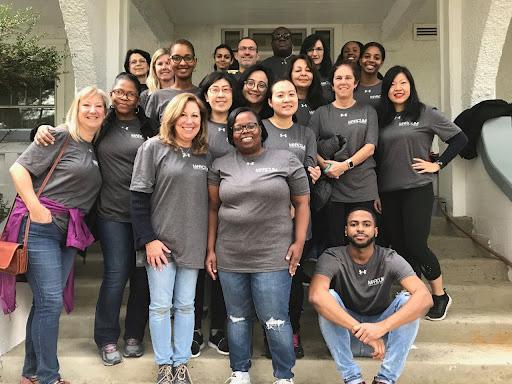
Inside the work of ‘Stepping Stones’
SOPHIA THOMAS Michael Stoops Diversity Fellow
In 1982, Stepping Stones Shelter made history as the first homeless shelter for families in Montgomery County, Md.
Today, it’s best known for its location in Rockville’s historic Dawson Farmhouse and for providing about 30 families with housing and services each year.
Stepping Stones houses families of all shapes and sizes; twoparent families, single parents, multigenerational households and anyone with custody of a minor. The shelter’s Hope Housing Program also provides permanent supportive housing for two families with disabled heads of household. Stacey Gold, Stepping Stones’ executive director, has navigated five years of growth and change at the shelter. Street Sense Media spoke with Gold about carrying on the shelter’s legacy.
Describe an experience you’ve had at Stepping Stones that captured the essence of the shelter.
There was a day when our copier broke and I had to call the copier company. I dialed in and I gave them our number, which is connected to the organization’s name. The lady I was talking to types in the number and was very businesslike the whole time. Then, I could see her leaning into the phone and she whispers to me, “Oh, Stepping Stones. I used to live there.”
I was so proud of her at that moment because she was working. That’s what we want. I want to hear that a family — that at one time had nothing — is now working for a company. I asked her how she’s been doing and how her family is and we talked about it. It was a sweet story.
How has family homelessness in Montgomery County changed since Stepping Stones was created?
I think families without knowledge of the system thought that they were going to get their kids taken away because they had no place to live. There are now two other shelters in Montgomery County that do what we do. They provide a safe place for families to stay together and work out the issue of being unhoused and figuring out how they’re going to move forward. In my time here, the biggest change has been the Housing First model. When I first got here, how you do things was much more punitive as far as what you can and cannot do in order to access shelter. Housing First has been the biggest change in the family shelters and all the shelters.
What’s the significance of running a family homeless shelter in the Dawson Farmhouse?
It was built by the Dawson family, who for generations, dating back to the Civil War, was a prominent family in Rockville. The matriarch built the house and the way the story goes —it’s a huge home— is that the main level is really for family and the second floor, which I call the resident hall, was for guests and people who were passing through and needed a place to stay. That was in 1912. Eventually, it became a private home and we bought it in 1982. In a different way, we’ve stayed really true to that mission of welcoming people who need a place to stay.
How many families currently live at Stepping Stones Shelter?
We have six rooms which allows us to have six families. We have five right now and one coming in today so we’ll be full. Each room is a different size, so we have a family as small as mom and baby, and then a room with a bunch of bunk beds that can fit ten.
Walk me through the process of staying at Stepping Stones. What’s the length of an average stay?
It’s been 60 to 90 days. (A family will) come in, they’ll bring their stuff, and we hit the ground running. They’ll do an intake with our case manager that consists of two things: gathering some level of information about the family and orienting them to the shelter. We show them the house — the kitchen, the
laundry room. They go through the resident handbook. After that happens, they move into a room. We have prepared their room in accordance with who’s coming in the family. Every room is customized. Books are placed in the room, stuffed animals. We try to make it so that when they walk in, they just breathe in a sigh of relief. There’s no more couch surfing, no more hotels. It’s clean and warm and friendly. Then after that, I say the real work begins, and that’s really where the case manager works with the family to identify all the barriers to obtaining stable housing and starts chipping away at those barriers.
Tell me about the relationship between Stepping Stones and families after they've passed through the organization's doors.
We help our families in any way they need. Some families leave the shelter with a case manager who checks on them once a month. We establish relationships with our families. Many of them come to trust the services and the people here. We are blessed with a robust donor base who bring so many goods here so that we’re able to meet the needs of families when they live here. When families leave, they fill out a wish list and we pack them up pots and pans and things like that. It’s not uncommon that a family might call and say “I’m running low on groceries, do you have food?” We will do our very best. We also have initiatives. We have Thanksgivings, school supplies that we give out, we invite our post-shelter families back to shop in
8 // STREET SENSE MEDIA // OCTOBER 19 - 25, 2022 NEWS
Stepping Stones staff pose on the steps of the shelter. Photo by Stepping Stones Shelter
our boutique to get gifts (at Christmas). Every time we have a point of contact, it’s an opportunity to talk to them. A lot of times, we identify who’s at risk of losing their housing, and the case manager and director of operations will start intervening on their behalf with the county. We’re all in it together.
Montgomery County is the wealthiest county in Maryland and one of the wealthiest in the United States. How effectively are families able to navigate living in Montgomery County after their time at Stepping Stones? How many leave the county?

Even though the county is generous and really cares for families and people in need, it’s expensive to live here. But people want to live here. They want their kids in the school system, so they work very hard to find a way. I know of a handful of our residents who have gone to Frederick and I know another who’s been back and forth to North Carolina. The most important thing to us is that we don’t want anybody to return to homelessness. In my time, I’ve seen maybe ten families return to homelessness. They may not come back here but I’m aware that they’re in the system.
How has the COVID-19 pandemic affected demand for your services and your ability to meet this demand?
During Covid, we stayed open 24/7. While we had a steady flow of families, it was quieter during Covid as far as the number of families who were coming into the shelter. I think families and friends were much more sympathetic and allowed people to stay with them. Nobody wanted to come into a congregate setting during Covid, and there was the eviction
moratorium. Once the eviction moratorium lifted, the families started coming through more and more.
What are Stepping Stones’ goals for the coming year?
The goal is always to move somebody out as quickly as possible in a responsible way. The other part of that is to do more for our families while they’re in the shelter. Instead of broadening our scope to more formally serve our post-shelter
families, we’ve decided to go deeper into how we help our families here at the shelter. The number one area is the workforce development stuff. Figuring out how a family can leave here with more skills and get them started on a path of doing more skills training. We want them to be working in a job that is going to pay them a little bit more so they can leave here and sustain their housing. That’s the goal. It’s very, very hard to achieve. But we’re going to try and we’re not going to stop.

STREETSENSEMEDIA.ORG // 9
A room at Stepping Stones Shelter is prepared to welcome a large family. Photo by Stepping Stones Shelter
A street view of Stepping Stones Shelter, located in the historic Dawson Farmhouse.
Photo by Stepping Stones Shelter
Public housing residents already knew DC’s housing authority was unacceptably dysfunctional
JEWEL STROMAN
Earlier this month, the Department of Housing and Urban Development (HUD) released a 72-page audit regarding the D.C. Housing Authority (DCHA). The audit highlighted a range of problems, including mismanagement of funds, a lack of operational oversight, and poor housing conditions.
While most lawmakers reacted with shock, HUD’s audit was old news for DCHA program participants like myself. While as a homeless advocate I have seen and heard horror stories regularly, recently I experienced my own DCHA nightmare when the agency granted my family an emergency move after my current home suffered extensive maintenance problems.
After orientation for my transfer voucher I discovered that among the paperwork DCHA sent they had failed to provide me with a copy of my actual voucher, something that many landlords are now asking applicants to show up front. It took two weeks of emailing DCHA before they sent it to me, but the damage had already been done. Their failure to provide me with my transfer voucher caused me to miss out on applying for several houses.
Then, to locate housing, DCHA referred me to a housing specialist at Community of Hope. She was inexperienced and showed me homes that were outside of my voucher rent reasonable amounts. When I asked my caseworker at Community of Hope for help, she was rude and appeared angry that I called her.
Then came the problems with DCHA’s online portal. When I was finally approved for a new home, my landlord was required to complete a packet and return it via this portal, which he did three times, without success. My landlord ended up emailing
the packet directly to a DCHA employee.
With help from my contacts at Councilmember Robert White’s office and the media, I was able to get DCHA to expedite my inspection for the new house. But most families without those connections are left waiting months for housing inspections.
There are many different departments within DCHA, and they often don’t communicate well. I know many folks who lost their housing vouchers and ended up homeless because during the voucher recertification process DCHA lost or misplaced the paperwork that folks turned in. DCHA is notorious for losing paperwork and then punishing the clients by marking them as non-compliant.
The pandemic has only amplified problems that have existed for decades at DCHA. Now that the majority of DCHA employees are working virtually from home, many voucher recipients like myself are left to wonder if they are actually doing any work at all.
The shock and outrage many D.C. elected officials expressed seems performative and politically motivated. How can they be surprised by something that they knew about for years and allowed to fester? It’s a shame in the nation’s capital the only time housing and homelessness becomes important is during elections or after HUD publishes damning evidence about DCHA.
For example, about one-fifth of DCHA’s housing units currently sit vacant. Some of these units have been deemed uninhabitable due to serious housing code violations, but others are ready to be leased, and unfortunately DCHA has failed to
match them with a tenant. The public housing waitlist hasn’t been updated in years, and no one seems to know how many people are currently even on it.
According to the Washington Post, one DCHA Board member recently recommended that HUD either completely take over DCHA or at least place it in receivership. At this stage in the game, I am forced to agree. I also think DCHA needs immediate changes in leadership at both the executive level and the DCHA Board of Commissioners. Its current director, Brenda Donald — who joined last year — is a longtime D.C. government official, but has no experience with housing.
I think the DCHA Board Committee should replace the board members with housing advocates, voucher recipients, and public housing residents because these are the people who have direct lived experience being housed under DCHA programs. These are the folks I would trust to make decisions that are in the best interest of residents instead of making decisions that are in the best interest of the Bowser administration.
I also echo Attorney General Karl Racine in his recent calls for the removal of Anita Bonds as chairwoman of the D.C. Council’s housing committee. For me, this is not about finger pointing, this is about accountability and corrective measures.
I also understand these problems have existed for decades and there is no quick fix solution. But DCHA needs to be reconstructed top to bottom. If the folks in charge are willing to accept that and take steps in that direction, I think that’s one hell of a start.
Jewel Stroman is a formerly homeless advocate for people experiencing homelessness.
Fox News is watered-down conservativism. It’s time for hard liquor governing
JEFFERY MCNEIL
I rarely watch cable news, but occasionally I watch Fox. Outside of Tucker Carlson, Fox News to me is no different than CNN and MSNBC. They all say the same thing: Donald Trump is bad and anyone that questions Joe Biden’s legitimacy is an ultra-MAGA.
As we approach the midterms, it’s obvious Americans have had enough of anything that has Democrats attached to it. But you wouldn’t know it watching Fox News, with its cast of weak, cowardly, go-along-to-get-along conservatives. Fox has a conservative version of the View, called the Five, with liberal guests such as Geraldo Rivera and Democratic strategist Marie Harf talking about finding common ground and unity.
This is where I grab my remote and click them off. Compromise on what? Free people can never submit to the gospel of government.
I was born to make my own choices, not have a panel of experts and managers make them for me. I was poor, lived on bologna sandwiches and noodles. I got out of poverty when I stopped listening to well-meaning liberals. If you disagree with that statement, call the NAACP, march, protest and cry your eyes out.
Republicans need to stop feeding into the left’s victimhood ideology and tell their viewers that socialism is not for Americans. This nation is built on grit, determination and pulling yourself up.
The Civil Rights Act outlawed racism nearly 60 years ago, America doesn’t discriminate against anyone. We have a Black vice president, Black press secretary, two Black judges on the Supreme Court, two Black senators from southern states, Black mayors, Black police chiefs and Black educators.
The same goes for guns. Why are feckless Conservatives debating liberals on the Second Amendment?
If politicians lowered gas prices, reduced crime and kept us out of war there would be no need for me to take up a weapon to defend my life, liberty and property. But when I have to come home every night to a drug dealer slinging dope on the corner, teenagers smashing windows and drug addicts breaking into my home, thank God for the Second Amendment.
The right to bear arms is non-negotiable. Liberals want to defund police, and at the same time want policemen and the armed forces to be the only ones with weapons. Might as well move to Iran or China. The only reason America will never have socialism enter this great country is the revolver.
Millions of Americans are not happy. Support is low for politicians of either party. Whether it’s Chuck Schumer or Mitch McConnell, Nancy Pelosi or Kevin McCarthy, replacing career Democrats with career Republicans is like replacing MSNBC with Fox News.
What America has is a Uni-party. Current leadership has
run up our deficit on never-ending wars, both parties have flipped working Americans the middle finger by handing out money to Fortune 500 companies that did fine during the Covid-19 pandemic.
While many Republicans are giddy that a red wave will change the direction of this country, I am skeptical. There should be a mutiny if I stand in line to vote Republican only to have Mitch McConell to be Senate Leader and Kevin McCarthy to be Speaker of the House.
A message to the GOP: The days of milquetoast Republicans such as Liz Cheney and Mitt Romney are over. What good is it to have power if you don’t wield it!
The first order of business should be to remove Biden either humanely by invoking the 25th Amendment, or if the Democrats want to be stubborn about it, bringing articles of impeachment.
We need to obliterate the nanny state and refuse to raise the debt limit unless there are huge spending cuts. McConell and McCarthy need to be blocked from leadership.
Neocon vs Neo-liberal is not an option. Globalism is good for the rich but not for Americans. We are not coming to make friends or reach across the aisle. We are put here to remove the poison known as Washington, D.C.
Jeffery McNeil is a vendor for Street Sense Media.
OPINION 10 // STREET SENSE MEDIA / OCTOBER 19 - 25, 2022
Dear Karen and Ken
DONTÉ TURNER Artist/Vendor
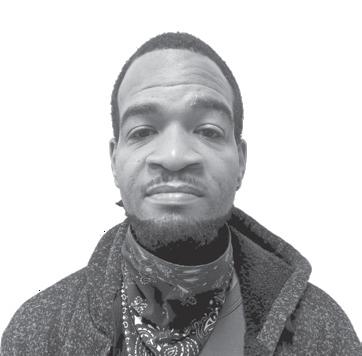
Dear Karen and Ken,
The reason for this article is to forewarn you to stop being outraged whenever you can’t get your way. Us minorities and people in homeless situations especially deal with mental health issues. Around half of the people I know who are homeless have a mental disability. We are liable to lash out with violence whenever a citizen or authority figure threatens us. Consequences and even death are the last things we think about. We fight to live everyday just to do regular things: get a job, get food, get housing, get the right counseling, get the help we need. We fight on a daily basis, because we lack what the government has stolen or allowed people to steal from us.
I, for one, am a minority and a person who has experienced homelessness. I don’t put things such as this subject on here just ‘cause. But I want you to open your eyes and get yourselves together and grow up. We (me especially) are tired of you all harassing us, then you wanna play victim after a verbal or physical assault has occurred. We can’t work on ourselves, because you won’t allow us to. If you give poison to somebody that’s already sick, they get sicker.
For instance, if I ask you for help, and you give me your middle finger and I already have an anger problem, you just made me sicker. Meaning, instead of finding a way to make me less angry, you’ve given me a reason to be more angry than I already am. Some of us carry legal weapons because kidnapping, theft, rape, assault, etc. happens to us on a daily basis. We don’t always know who is who, and we are paranoid because we don’t know what bad is in store for us that day. It could be from food to the weather, clothing, showering, sleeping, or just darn living.
We even have Karen and Ken situations with people that work within homeless services organizations. For example, counselors that are supposed to counsel us. How are you a counselor and you get into heated debates with the person you’re supposed to counsel? If counselors are supposed to help you to learn how to de-escalate situations, then why are they engaging in them?


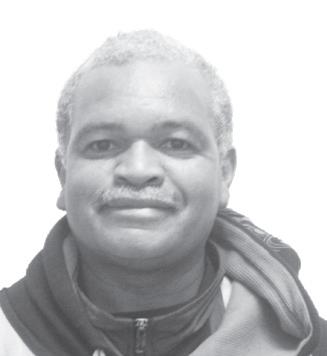
So, Karen and Ken, please think about these things the next time you engage in unnecessary drama that can be avoided by you all just “MYODB” (Minding Your Own Damn Business), because some people might not have taken their medication on that specific day. Thank You.
Sincerely, Minorities and People that are just tired of you.
Powerful with a pen
LEVESTER GREEN Artist/Vendor
Things seem just out of my arm’s reach. I need to come strong, but then that would be a strong arm, and that’s robbery.

Maybe I’m wrong because they have been robbing me for years, but still, two wrongs don't make a right. Fighting for justice is one hell of a fight.
I tried to turn the other cheek, but that only made them label me weak, so now I try to watch each and every word I speak because it’s the truth of the matter that I seek, not the back door out you sneak.
I believe this is what it’s like being powerful with a pen, being able to pick a fight or gain a friend (in Christ for life).
Blessings of love
KYM PARKER Artist/Vendor
The world today has death and pain.
Today I watched the TV and I saw a lot of pain, death and people hurting.
We need to open our eyes as beings of God; we need to care for each other and support each other. Yet, I see people killing other people. Why? I ask myself the question, why?
We have to stay together as children of God and support each other.
I know God will wash away all the pain of humanity. I know she will bless us because she loves and cares for us.
All I want
QUEENIE FEATHERSTONE Artist/Vendor
I don’t want to be alone in my new home. All I want is to be at his or her feet.
I don’t want for anyone to be unhoused. All I want is to greet and serve them.
Let’s talk
DANIEL BALL Artist/Vendor
First of all, if you want to get my full attention, you must invite me to dinner and to take me to see a good movie.
Now let’s talk about the word “problem.”
The only problem I have is selling my Street Sense paper on 19th St. NW. Because the new food court is still closed.

Now let’s talk about the word “example.” Yes, Jesus will always be a positive example in Daniel Ball’s life. And thank you to Will and Maria for organizing our writer’s group.
The great poet
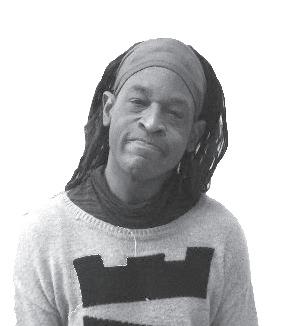 ANTHONY CARNEY
ANTHONY CARNEY
One sunny day at the library, I met the late Gwendolyn Brooks. She was a nice lady. She was old enough to be my grandmother. I got her autograph. What an excellent summer for the
No rubles
JAMES DAVIS Artist/Vendor
The war in Ukraine is taking a toll
People out in the autumn air, taking a stroll
The economy is fresh on our minds

As election time nears and we fight long lines
The homeless are sheltering in their tents
While others still finding ways to pay their rents
Gun violence is up all over the city
Another teenage bystander dies, what a pity
Chill in the air and a chill in the breeze
As a Street Sense vendor shouts “No rubles please!”
STREETSENSEMEDIA.ORG // 11
My rise and fall in life

overpowering and haunting.
Its music puts me on high alert, pokes at my nerves, makes my head hurt. Why are organs only played in church?
Not easy
ABEL PUTU Artist/Vendor

I slept in the streets for a long time. It's not easy. I didn't have a tent, so I had to sleep in my wheelchair. Unfortunately, people robbed me often while I was asleep. They even took my shoes. This made me stronger. I have experienced a lot, and people don't see this. Homeless people need our help. Living in the streets is difficult. We must realize that. Now, they are trying to clean the tents in the city. That's terrible. People need our support.

I am trying to be strong and push through another test of life again. One year ago in December, my life changed for the worse. I had worked myself off the streets and was working as a driver for a company for six years. Well, thanks to the police, my clean driver’s record was tarnished and I am behind on bills and about to lose my car. And my bank is drained of all the savings I had.
It all began when I was driving home from work one day in a storm. I had just finished a 12 hour shift and my phone fell off of my center console. It rolled beneath my seat, so I pulled over. Since the storm was heavy, I decided to stay there for a few minutes. But before long, a cop pulled up to me and accused me of drinking.
He gave me a breathalyzer and I blew a 0.00. I knew I would be fine because I hadn’t been drinking, I had just come off of work. But the cop decided this wasn’t enough and said he wanted a blood sample.
So he took me to the precinct and put a tow sticker on my car. But since I didn’t break the law, they had to take me back. In fact, the judge who later dismissed the case said the policeman didn’t follow the proper procedures. Even as the policeman was ordered to take me back to my car, he just put me out on the highway and told me to find my own way there.
It was close to 1 a.m. and I had to walk down the highway before I could find it. When I told this story to one of my customers, they asked me if it was a white cop who did this. I said, “Nope, it was a Black cop.”

This unforeseen incident has cost me a lot of money and time wasted, going to and from courts. Even though I’ve been acquitted of all charges and I have paperwork to prove my innocence, my driving record is still tarnished.
Despite this bad news, I’m trying to stay positive. I know this is only a test for me. It is nothing new to me. Things like this happen and you can’t know why, especially when things are going good and you think you have everything together. I know I will rise again. I know this is just another road I have to cross. It’s just one more road I have to take.
In God I trust
ERIC GLOVER Artist/Vendor
I’ve fallen so many times in life. Sometimes I really feel like giving up on myself and on life. There were times I wanted to take my life or even hate God. I thought he was punishing me for the wicked things I have done but I have come to realize that God punishes you to help you understand the faults within yourself. It’s called a reality check.
Practice what you preach. Some things that come out of your mouth can be your own lessons. The Lord will direct you to a life of abundance. I trust the Lord with all my heart. He will test you and your faith, you have to go through trials and tribulations to help you become strong in your faith. My favorite story about faith is about Joseph, the son of Jacob. He was betrayed by his brothers. He realized his prideful ways. Having trust and accepting God’s guidance is a must. I am struggling with that now. So remember, have faith.
Trying to remember my mother
JEANETTE RICHARDSON Artist/Vendor
As I get older, I can feel it in my spine. I was hit on a bike and came down on it. We went to the hospital and they said to soak it.
I remember being left alone in this big house on Park Road Northwest. And then seeing a big shadow come and take me outside for a little while before leaving me alone all again. Then, one day, I was taken to Jr. Village for placement into foster care.
I don’t remember my mother but I think my father was the one who would come to see me and who made sure I was taken into a better shelter home.
I still try to remember my mother but no matter how hard I try, I can’t see her. I can’t see my mother. I’ve tried everything. I’ve meditated. I just want to meet her. I was just a small child when I last saw her. Mothers are very important in a small child’s life and I think they are bonded eternally through love.
12 // STREET SENSE MEDIA // OCTOBER 19 - 25, 2022 ART
The aftermath of the quiet storm
ERICA DOWNING Artist/Vendor

Being Cinderella and Beauty wrapped in one has created unique chapters in the story of my life. Replace the evil stepmother with a narcissistic mother with sons held in higher regard and admiration than the eldest daughter from the first marriage. The sight and presence of the eldest brings a flood of negative energy and emotions from memories of times of turmoil experienced throughout the upbringing of that child. As the matriarch battles her own demons, they are frequently unleashed on unwitting innocents around her, especially those who are attempting to provide a service to her untrusting soul.
Learning Food
JACKIE TURNER Artist/Vendor
Sitting here in this high chair, Dressed with my bib on, Looking at this food my mama made.
It’s bright-colored, smooth looking I don’t know, throw it, if I want it.

She spooning and says, “it’s good, baby. Open you mouth and try it.”
So, I bat my eyes, like daddy says, to be pretty and hope she don’t keep pushing it
But she don’t stop. She says, “try the potatoes with applesauce.” That word sounds familiar, I’ve heard that word “applesauce” before. I taste it and find I can eat anything as long as it has apple sauce.

The upbringing left the eldest daughter with a void that was hard to fill. She sought out compassion and love in the world and was led into the arms of beasts time and time again. Each beast would take advantage of her desire and need for affection in various ways, violating her body and manipulating her mind for their own benefit, desires and needs, quenching their demons.
Beauty was released from the abusive cycle once the light from within her was revealed to her through the birth of her first child from her last and final beast. The physical and mental abuse felt deserving to her for years, but that


Gravy
FREDERIC JOHN Artist/Vendor

A fave name I took Was “Gravy,” No chef as a child was I: Mercy wild!

The sauce was easier to stir Than the roast was to “Broast”— Call me anything you want, But don’t — Call me “Late for dinner!” (now, that’s a winner)
day the brightest light she had ever seen glowed in her arms. Life of her creation to nurture and love. The process and product gave new meaning to all that had happened and all to come. At that moment, she realized her internal and external beauty and a new chapter began.
The beast was removed from her life and she began to strengthen her mind and body. Realizing, knowing she deserved better — she deserved more. The journey will never end but the road only gets clearer as the light within gets brighter each day, with every new obstacle overcome.
Rolling stones moving with speed downward off a hill
CARLTON JOHNSON
They move with the speed of Mother Nature. It’s rather loud and brings the untold sound of a roar. It’s a standing sign of education. A sign of educated movements befriending the living. It is life in your heart and soul for the days to come.
STREETSENSEMEDIA.ORG // 13
We are devoted to being a good neighbor in every community we serve. That’s why we’re working with customers like you to help our communities thrive. Your support allows us to give more and do more to improve lives and make our neighborhoods stronger. Thank you for helping us make a difference. 202-449-1600 • WISCONSIN AVE. 41 Ridge Sq. NW, Washington, DC 20016 Join the conversation, share your views - Have an opinion about how homelessness is being addressed in our community? - Want to share firsthand experience? - Interested in responding to what someone else has written? Street Sense Media has maintained an open submission policy since our founding. We aim to elevate voices from across the housing spectrum and foster healthy debate. Please send submissions to opinions@streetsensemedia.org
the
Stepped on
Seafood staple
Quiche ingredients
Only Just Begun"
Where the heart is, they say
Jeopardy
Film featuring Damien, with "The"
the briny
Battery terminal
Social "Peanuts" character?
Milit school based in Annapolis
Battles hip score
Supplement, with "out"
Declined a bid
Pains”
Inner souls, to Jung
famous
Kentucky potables
18 wheelers
Alan of "Growing Pains"
Site of a famous fall
merriment
Driftwood site

Vega's constellation
Farthest
Marlon of “Scary
States of merriment
before cooker or point
(ice
Shawn or Marlon of "Scary Movie 2"
Motion detector
60% of the world
Needlefish
Caviar, essentially
Subject Was Roses”
Heavenly (ice cream flavor)
hangouts
1 Clown's perk?
Right Stuff” author Tom
Down
Down
1 Double cycled, like some electric motors
1. Double-cycled, like some electric motors
Stuck around
Paycheck figure
Bumper mishap
Decorates the sidewalk, maybe
Celebrity run magazine formerly called McCall's
David Copperfield’s wife
Like 60% of the world population
With the bow, to a violinist
"The Subject Was Roses" actress Patricia
New Jersey NBA team
Sole
Lions' hangouts
River to the North Sea
"The Right Stuff" author
Shout from the congregation
Inamorato
Smog watching gp.
2. Stuck around 3. Paycheck figure 4. Bumper mishap 5. Decorates the sidewalk, maybe 6. Celebrity-run magazine formerly called McCall’s 7. Shout from the congregation 8. Inamorato 9. Smog-watching gp. 10. Biological classification that includes actress LeBrock?
Biological classification that includes actress
11. “___ Pointe Blank” (John Cusack film)
16 Journalist's sources
Positive votes
. Little girl ingredient?
" Jeeves" (Internet inquiry service)
29 What the 1973 film became after it was just "In Africa?"
12. “Windmills of the Gods” author Sheldon 16. Journalist’s sources 21. Positive votes 22. Little girl ingredient? 27. “___ Jeeves” (Internet inquiry service) 29. What the 1973 film became after it was just “In Africa?”

" Line Is It Anyway?" 31. Trumpeter Al 33 God of thunder 35 Blue cartoon character 37 They long a lot

30. “___ Line Is It Anyway?” 31. Trumpeter Al 33. God of thunder 35. Blue cartoon character
37. They long a lot 38. Abdicate 39. Property tax estimator 41. General’s name on a chicken dish 42. Clothing 43. “I don’t buy it!” 44. Use logic 45. Store, as fodder 46. Lie in wait for 48. Bend out of shape 52. Backtracking computer command 53. Las Vegas gas 54. Jazz singer Anita 56. Former Sega competitior, for short
41 General's name on a chicken dish 42 Clothing 43 "I don't buy it!" 44. Use logic 45 Store, as fodder 46 Lie in wait f or 48 Bend out of shape 52 Backtracking computer command 53 Las Vegas gas 54 Jazz singer Anita 56 Former Sega competitior, for short
14 // STREET SENSE MEDIA // OCTOBER 19 - 25, 2022 FUN & GAMES Answers Intermediate Sudoku by KrazyDad, Volume 20, Book 50 Sudoku #1 2 7 3 5 1 1 4 3 6 9 8 9 5 8 2 1 7 6 4 5 9 4 2 3 8 7 6 1 4 9 9 1 3 7 5 6 1 7 4 9 8 2 4 3 2 8 5 9 8 9 2 6 1 6 8 4 9 7 5 2 3 1 6 7 8 3 5 2 2 4 8 6 5 3 7 1 6 3 5 4 7 Sudoku #2 1 9 4 6 5 3 8 7 1 2 5 9 5 6 9 2 7 2 3 4 9 6 3 1 5 9 4 7 8 2 9 8 1 6 3 7 2 5 4 2 7 4 3 6 1 9 1 8 9 2 3 2 8 3 7 4 6 4 3 7 1 8 5 6 8 1 4 2 7 5 9 3 6 1 8 8 5 4 6 5 7 Sudoku #3 6 2 4 5 3 9 5 7 1 9 6 4 8 2 4 8 6 1 6 5 4 7 8 2 7 6 3 8 9 4 3 2 1 9 5 6 3 4 9 9 2 5 8 6 7 4 3 8 4 3 2 1 6 8 7 1 3 3 9 2 1 5 7 9 2 3 5 1 4 8 7 6 1 7 5 8 2 1 7 9 5 Sudoku #4 5 7 6 6 8 9 4 2 5 8 3 4 2 7 1 6 6 1 9 4 7 5 2 3 5 9 4 2 9 6 5 3 8 7 1 9 4 3 2 6 8 7 2 6 8 9 3 7 6 4 4 2 1 3 9 8 1 7 3 9 5 8 3 7 2 1 8 6 4 1 5 7 4 1 5 5 3 8 1 2 9 Sudoku #5 1 8 9 2 4 7 3 5 4 3 1 6 6 5 2 7 8 9 9 4 2 3 1 56 8 7 & Fill in the blank squares so that each row, each column and each 3-by-3 block contain all of the digits 1 thru 9. If you use logic you can solve the puzzle without guesswork. Need a little help? The hints page shows a logical order to solve the puzzle. Use it to identify the next square you should solve. Or use the answers page if you really get stuck. © 2019 KrazyDad.com Sudoku #4 Intermediate Sudoku by KrazyDad, Volume 20, Book 50 "God sleeps in the minerals, awakens in plants, walks in animals, and thinks in man." -Arthur Young 4 2 1 3 9 8 1 7 3 9 5 8 3 7 2 1 8 6 4 1 5 7 4 1 5 5 3 8 1 2 9 Across 1. Stepped on 5. Seafood staple 9. Quiche ingredients 13. “___ Only Just Begun” 14. Where the heart is, they say 15. Jeopardy 17. Film featuring Damien, with “The” 18. On the briny 19. Battery terminal 20. Social “Peanuts” character? 23. Milit. school based in Annapolis 24. Battleship score 25. Supplement, with “out” 26. Declined a bid 28. Inner souls, to Jung 30. Kentucky potables 32. 18-wheelers 33. Alan of “Growing
34. Site of a
fall 35. Driftwood site 36. Vega’s constellation 40. Farthest 42. States of
43. Word before cooker or point 46. Shawn or
Movie 2” 47. Motion detector 48. Needlefish 49. Caviar, essentially 50. Heavenly ___
cream flavor) 51. Clown’s perk? 55. Like
population 57. “The
actress Patricia 58. Lions’
59. “The
60.
61.
62.
63.
64.
Find the solution at https://onlinecrosswords net/5926 OnlineCrosswords.net This is
Daily Crossword Puzzle #2 for Oct 18, 2022 Across 1
5
9
13 "
14
15
17
18 On
19.
20
23
24
25
26
28
30
32
33.
34
35
36.
40
42
43 Word
46
47
48
49
50
5
55
57
58
59
T
2
3
4
5
6
7
8
9.
10
21
22
27
30
© ONLINECROSSWORDS.NET
>> This crossword puzzle’s answers: https://tinyurl.com/SSMcross-10-19-2022 << LAST EDITION’S PUZZLE SOLUTION <<
SHELTER
YOUTH
DOMESTIC
1-800-799-7233
BEHAVIORAL
salud
1-888-793-4357
JOB BOARD
Team Member
Academy of Hope Public Charter School 202-269-6623 // 2315 18th Place NE aohdc.org
Bread for the City - 1525 7th St., NW // 202-265-2400 - 1700 Good Hope Rd., SE // 202-561-8587 breadforthecity.org
Calvary Women’s Services // 202-678-2341 1217 Good Hope Rd., SE calvaryservices.org
Catholic Charities // 202-772-4300 924 G St., NW catholiccharitiesdc.org/gethelp
Central Union Mission // 202-745-7118 65 Massachusetts Ave., NW missiondc.org
Charlie’s Place // 202-929-0100 1820 Connecticut Ave., NW charliesplacedc.org
Christ House // 202-328-1100 1717 Columbia Rd., NW christhouse.org
Church of the Pilgrims // 202-387-6612 2201 P St., NW food (1-1:30 on Sundays only) churchofthepilgrims.org/outreach
Community Family Life Services 202-347-0511 // 305 E St., NW cflsdc.org
Community of Hope // 202-540-9857 communityofhopedc.org
Covenant House Washington 202-610-9600 // 2001 Mississippi Ave., SE covenanthousedc.org
D.C. Coalition for the Homeless 202-347-8870 // 1234 Massachusetts Ave., NW dccfh.org
Father McKenna Center // 202-842-1112 19 Eye St., NW fathermckennacenter.org
Food and Friends // 202-269-2277 (home delivery for those suffering from HIV, cancer, etc) 219 Riggs Rd., NE foodandfriends.org
Friendship Place // 202-364-1419 4713 Wisconsin Ave., NW friendshipplace.org
Georgetown Ministry Center // 202-338-8301 1041 Wisconsin Ave., NW georgetownministrycenter.org
Loaves & Fishes // 202-232-0900 1525 Newton St., NW loavesandfishesdc.org
Martha’s Table // 202-328-6608 marthastable.org 2375 Elvans Road SE
2204 Martin Luther King Ave. SE
Miriam’s Kitchen // 202-452-8926 2401 Virginia Ave., NW miriamskitchen.org
My Sister’s Place // 202-529-5261 (24-hr hotline) mysistersplacedc.org
N Street Village // 202-939-2076 1333 N St., NW nstreetvillage.org
New York Avenue Shelter // 202-832-2359 1355-57 New York Ave., NE
Samaritan Inns // 202-667-8831 2523 14th St., NW samaritaninns.org
Samaritan Ministry 202-722-2280 // 1516 Hamilton St., NW 202-889-7702 // 1345 U St., SE samaritanministry.org
Sasha Bruce Youthwork // 202-675-9340 741 8th St., SE sashabruce.org
So Others Might Eat (SOME) // 202-797-8806 71 O St., NW some.org
Thrive DC // 202-737-9311 1525 Newton St., NW thrivedc.org
Unity Health Care 3020 14th St., NW // unityhealthcare.org - Healthcare for the Homeless Health Center: 202-508-0500 - Community Health Centers: 202-469-4699
1500 Galen Street SE, 1251-B Saratoga Ave NE, 1660 Columbia Road NW, 4414 Benning Road NE, 3946 Minnesota Avenue NE, 765 Kenilworth Terrace NE, 3240 Stanton Road SE, 3020 14th Street NW, 1717 Columbia Road NW, 1313 New York Avenue, NW BSMT Suite, 425 2nd Street NW, 4713 Wisconsin Avenue NW, 1333 N Street NW, 1355 New York Avenue NE, 828 Evarts Place NE, 810 5th Street NW, 850 Deleware Avenue SW, 65 Massachusetts Avenue NW, 4515 Edson Place NE
Washington Legal Clinic for the Homeless 1200 U St., NW // 202-328-5500 legalclinic.org
The Welcome Table // 202-347-2635 1317 G St., NW. epiphanydc.org/thewelcometable
Whitman-Walker Health 1525 14th St., NW // 202-745-7000 2301 MLK Jr. Ave., SE // 202-797-3567 whitman-walker.org
Wegmans // 41 Ridge Sq. NW
Part-time
Hiring for positions across the store, including cashier, parking lot attendant, e-commerce store shopper, custodian, dishwasher, product stocker and food customer service.
REQUIRED: N/A
APPLY: https://tinyurl.com/wegmans-team-mem
Seasonal Retail Receiving Support Associate
Macy’s // 1201 G St NW
Part-time
Pack and stock merchandise, maintain sales floor and stockroom.
REQUIRED: Lift up to 50 pounds.
APPLY: https://tinyurl.com/macys-stock
Customer Service Associate
Walgreens // 1155 F Street NW
Full-time/Part-time
Assist customers at cashier and throughout the store.
REQUIRED: N/A
APPLY: https://tinyurl.com/walgreens-job
STREETSENSEMEDIA.ORG // 15
COMMUNITY SERVICES
Housing/Shelter Vivienda/alojamiento Case Management Coordinación de Servicios
HOTLINE Línea directa de alojamiento (202) 399-7093
HOTLINE Línea de juventud (202) 547-7777
VIOLENCE HOTLINE Línea directa de violencia doméstica
HEALTH HOTLINE Línea de
del comportamiento
Education Educación Food Comida Health Care Seguro Employment Assistance Assitencia con Empleo Clothing Ropa Transportation Transportación Legal Assistance Assistencia Legal Showers Duchas Laundry Lavandería
All services listed are referral-free
Hiring? Send your job postings to editor@StreetSenseMedia.org For further information and listings, visit our online service guide at StreetSenseMedia.org/service-guide Last updated May 25, 2022



OCT. 19 - 25, 2022 | VOLUME 19 ISSUE 48 From your vendor, Thank you for reading Street Sense! 5,700 VENDORS WWW.INSP.NGO 3.2 million READERS 90+ STREET PAPERS 35 COUNTRIES 25 LANGUAGES NO CASH? NO PROBLEM. WE HAVE AN APP! SEARCH “STREET SENSE” IN THE APP STORE GIGI DOVONOU Artist/Vendor























 ANTHONY CARNEY
ANTHONY CARNEY

















